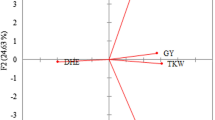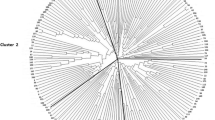Abstract
Diversity and relationships among ten tetraploid wheat landrace populations, collected from different localities in the central highlands of Ethiopia, were studied using isozyme markers and agronomic traits. This type of analysis in crop species is fundamental for designing optimal germ plasm collection, management practices and for developing an index for parental selection. The populations differed in allelic frequencies. Gene-diversity estimates showed that the populations encompass an appreciable amount of variation. However, differentiation between them was low, as was also confirmed by the presence of gene flow. Much of the diversity (85%), was attributable to the within-population level. The genetic distances were mostly small with the exception of those between a few pairs of populations. Thus, the relationships discerned among the populations were more of a similarity nature which could be ascribed to sharing a common ancestral population and/or adaptation to similar climatic conditions. The pattern of genetic divergence appeared to be independent of geographic distance. Considerable divergence in the agronomic traits was observed for certain populations. Cluster analyses of the isozyme and agronomic data produced different patterns and memberships of groupings. This lack of agreement could be ascribed to the different forces of evolution acting on isozyme markers and agronomic traits since agronomic traits, are the prime target of artificial selection. The clustering based on agronomic traits resulted in grouping together populations with similar agronomic performance. The results of this study suggest that taking more samples within a locality or population would be a better approach to capture the range of variation in the landrace populations of the central highlands of Ethiopia.
Similar content being viewed by others
References
Anderson E (1961) The analysis of variation in cultivated plants with special reference to introgression. Euphytica 10:79–86
Asins MJ, Carbonell EA (1989) Distribution of genetic variability in a durum wheat world collection. Theor Appl Genet 77:287–294
Brown AHD (1978) Isozymes, plant population genetic structure and genetic conservation. Theor Appl Genet 52:145–157
Brown AHD, Munday J (1982) Population genetic structure and optimal sampling of landraces of barley from Iran. Genetica 58:85–96
Brown AHD, Nevo E, Zohary D, Dagan O (1978) Genetic variation in natural populations of wild barley (Hordeum spontaneum). Genetica 49:97–108
Cross RJ (1994) Geographical trends within a diverse spring barley collection as identified by agro/morphological and electrophoretic data. Theor Appl Genet 88:597–603
Harlan JR (1971) Agricultural origins: centers and non-centers. Science 174:468–473
Kahler AL, Lay CL (1985) Genetics of electrophoretic variants in the annual sunflower. J Hered 76:335–340
Manly BFJ (1986) Multivariate statistical methods. A primer. 2nd edn. Chapman and Hall, London
Murphy JP, Cox TS, Rodgers DM (1986) Cluster analysis of red winter wheat cultivars based upon coefficients of parentage. Crop Sci. 26:672–676
Nei M (1973) Analysis of gene diversity in sub-divided populations. Proc Nat Acad Sci 70:3321–3323
Nei M (1978) Estimation of average heterozygosity and genetic distance from a small number of individuals. Genetics 89:583–590
Nevo E, Beiles A (1989) Genetic diversity of wild emmer wheat in Israel and Turkey: structure, evolution and application in breeding. Theor Appl Genet 77:421–455
Peeters JP, Martinelli, JA (1989) Hierarchical cluster analysis as a tool to manage variation in germ plasm collections. Theor Appl Genet 78:42–48
Rebordinos L, Peres de la Vega M (1990) Genetic variability of leaf esterases in Triticum aestivum L. 2n=6x=42. Theor Appl Genet 79:673–678
Rohlf FJ (1993) Numerical taxonomy and multivariate analysis system, version 1.80. 100 North Country Road, Setauket, New York
Slatkin M, Barton NH (1989) A comparison of three indirect methods for estimating average levels of gene flow. Evolution 43:1349–1368
Souza E, Sorrells ME (1991a) Relationships among 70 North American oat Germ plasms. I. Cluster analysis using quantitative characters. Crop Sci 31:599–605
Souza E, Sorrells ME (1991b) Relationships among 70 North American oat germ plasms. II. Cluster analysis using qualitative characters. Crop Sci. 31:605–612
Tesemma T, Belay G (1991) Aspects of Ethiopian tetraploid wheats with emphasis on durum wheat genetics and breeding research. In: Mariam HG, Tanner DG, Hulluka M (eds) Wheat research in Ethiopia: a historical perspective. IAR/ CIMMYT, Addis Ababa, pp 47–71
Tesfaye T, Getachew B, Worede M (1991) Morphological diversity in tetraploid wheat landrace populations from the central highlands of Ethiopia. Hereditas 114:171–176
Tsegaye S (1996) Estimation of outcrossing rate in tetraploid wheat (Triticum turgidum L.) landraces. Plant Breed (in press)
Tsegaye S, Tesemma T (1995) The genetics of some isozyme variants in tetraploid wheats (Triticum turgidum L.). Hereditas 123:147–154
Tsegaye S, Becker H, Tesemma T (1994) Isozyme variation in Ethiopian tetraploid wheat (Triticum turgidum) landrace agrotypes of different seed color groups. Euphytica 75:143–147
Author information
Authors and Affiliations
Additional information
Communicated by P. M. A. Tigerstedt
Rights and permissions
About this article
Cite this article
Tsegaye, S., Tesemma, T. & Belay, G. Relationships among tetraploid wheat (Triticum turgidum L.) landrace populations revealed by isozyme markers and agronomic traits. Theoret. Appl. Genetics 93, 600–605 (1996). https://doi.org/10.1007/BF00417954
Received:
Accepted:
Issue Date:
DOI: https://doi.org/10.1007/BF00417954




